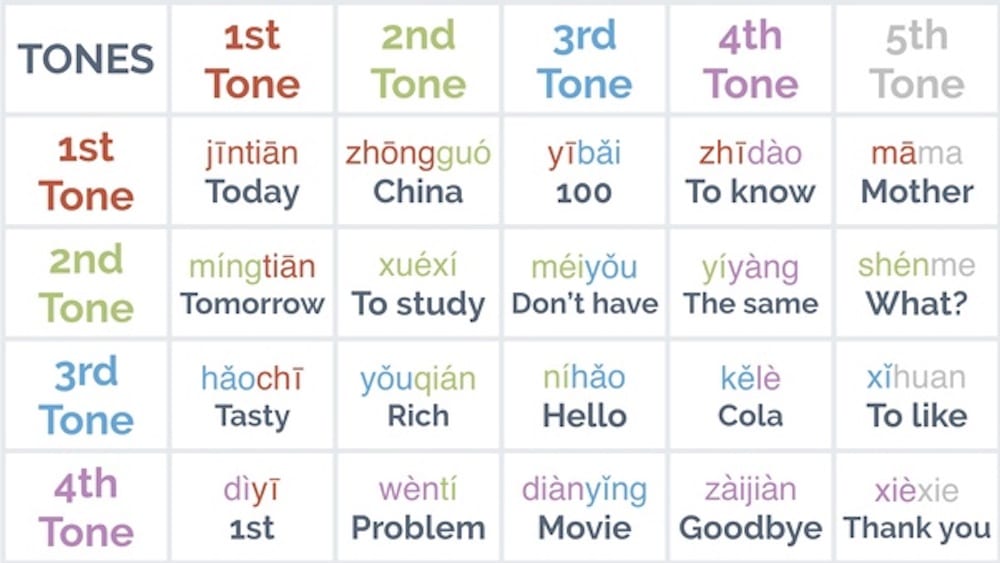5.Tackling the Tones
The tones are one of the most challenging aspects of Mandarin. But as always, practice makes perfect. As an English speaker, you might not realise this, but you already use tones in your speech. When speaking Mandarin, we just apply these tones differently.
Speaking Mandarin requires you to spend time familiarizing yourself with the tones and practice those tones, especially tone-pair based practice. It is not enough to quickly cover the tones and move on – it requires constant practice.
6. Why are tones important?
Tones are important in Mandarin because they alter the meaning of a word at the character level. In English we generally use tone to alter meaning at a sentence level rather than the character/word level.
For example:
“I really like THAT dress” vs “I REALLY like that dress”.
So, when we compare the two languages; In a ten-character sentence in Mandarin presents ten opportunities to change the tone and what you’re trying to say. Your progress is dependent on continuing to communicate in Mandarin as much as possible.
An incorrect tone may be understood by a native speaker if you get all the other tones around it correct, but you still need to get the rest of the context correct in the first place to save that failed tone!
7. Tone equivalents in English
When we use tones in English, we apply it on a phrase or at a sentence-based level, rather than on an individual sound.
The first tone is like singing a musical note, high and level. Think Mi from Do, Re, Mi.
The second tone (rising) is pronounced as a questioning tone that we would normally use at the end of an interrogative sentence in English.
The biggest difficulty here is divorcing that upward lilt from the concept of questioning. Some beginners will find that they inflect upwards at the end of sentence because they are so used to inflecting questions. So 你好吗 comes out as nǐhǎo má? This is a confusion of sentence level and character level tones – applying existing English intonation to Chinese.
The third tone is the trickiest of the lot. For one, we don’t have an equivalent in English. Also, the traditional falling/rising conception of the third tone is a useful approximation but not quite accurate. Finally, the third tone is also very liable to be changed by the tone that follows it. This means that the sound of the third tone in isolation is very different how it is pronounced in words and sentences.
This means that learning the third tone will take up most of your time when learning Mandarin. One piece of advice is not to worry too much about how the third tone sounds in isolation (the rising-falling conception). Instead focus on how it sounds with other tones inside words. This is the idea behind tone-pairs.
The fourth tone (falling) sounds like the way we express annoyance in English. Like “What?” when we are angry, the tone falls sharply.
8. Tone Pairs
Once you’ve nailed the tones in isolation move as quickly as possible to tone-pair combinations. Many Mandarin words are a pair of characters. When starting to learn Mandarin, many students spend too long focusing on sounds and tones in isolation.
These are all the tone pairs possible in Mandarin. You’ll never see a neutral tone preceding another tone which is the reason why this is not a 5 x 5 grid.

The basic idea behind tone-pair drills is to practice saying these phrases until it’s second nature. Because these are all the possible tone-pair combinations in Mandarin, when you learn new vocabulary, you’ll be able to hook the new pronunciation to the existing tone pair framework that you’ve been practicing.
Pay attention to those that include the third tone due to the third tone change rules. For instance, 3-3 你走 will be pronounced nízǒu rather than nǐzǒu.
Spending some time drilling the tone-pairs is much more worthwhile than practicing the tones in isolation. Tone-pair drills are not taught as often as they should be and are a very valuable method for achieving native-like pronunciation.
To practice tone pairs either use the chart above and repeat, repeat, repeat. You should also practice these tone-pairs with a tutor who can guide you and answer questions if you get stuck along the way.
For that and everything else you might need, the Agape School of Education is here for you!



0 Comments